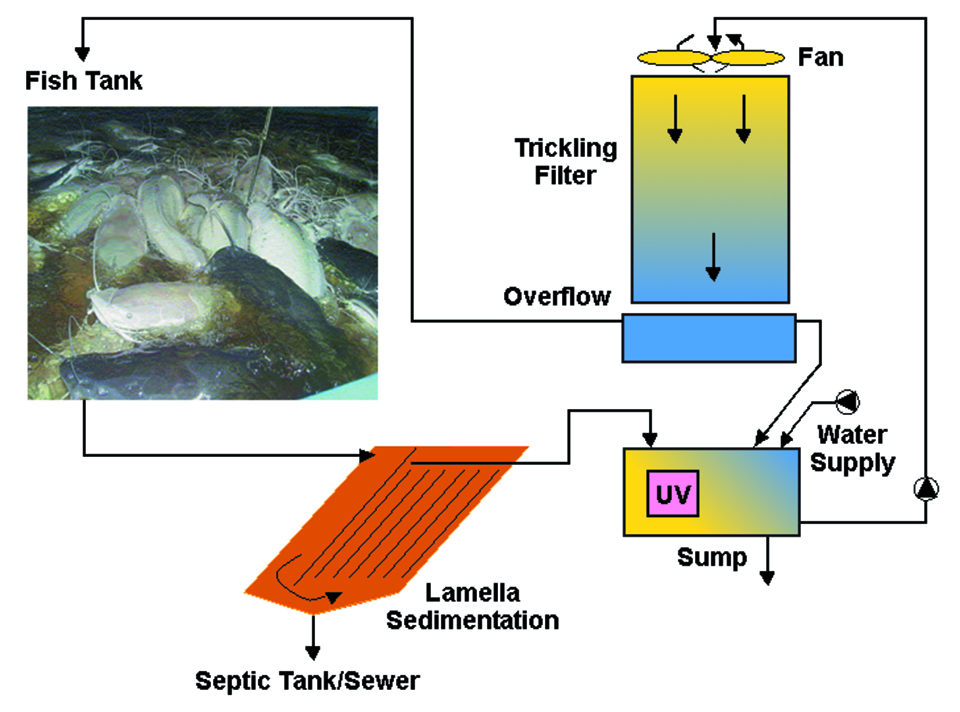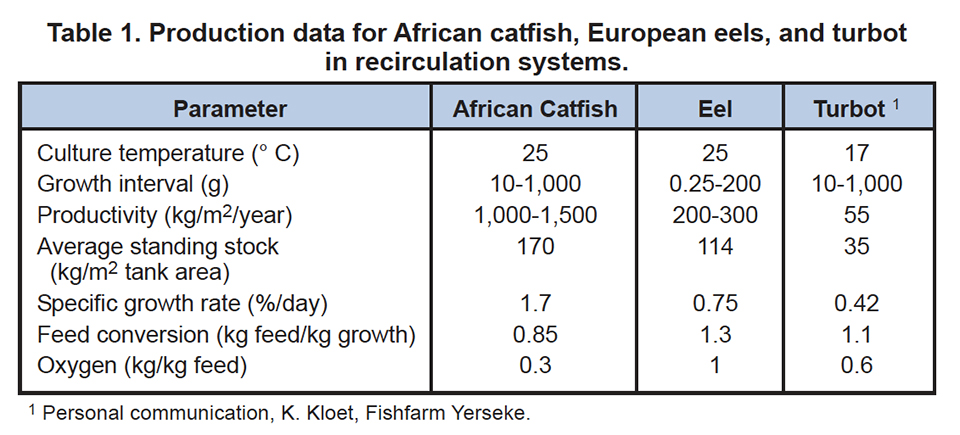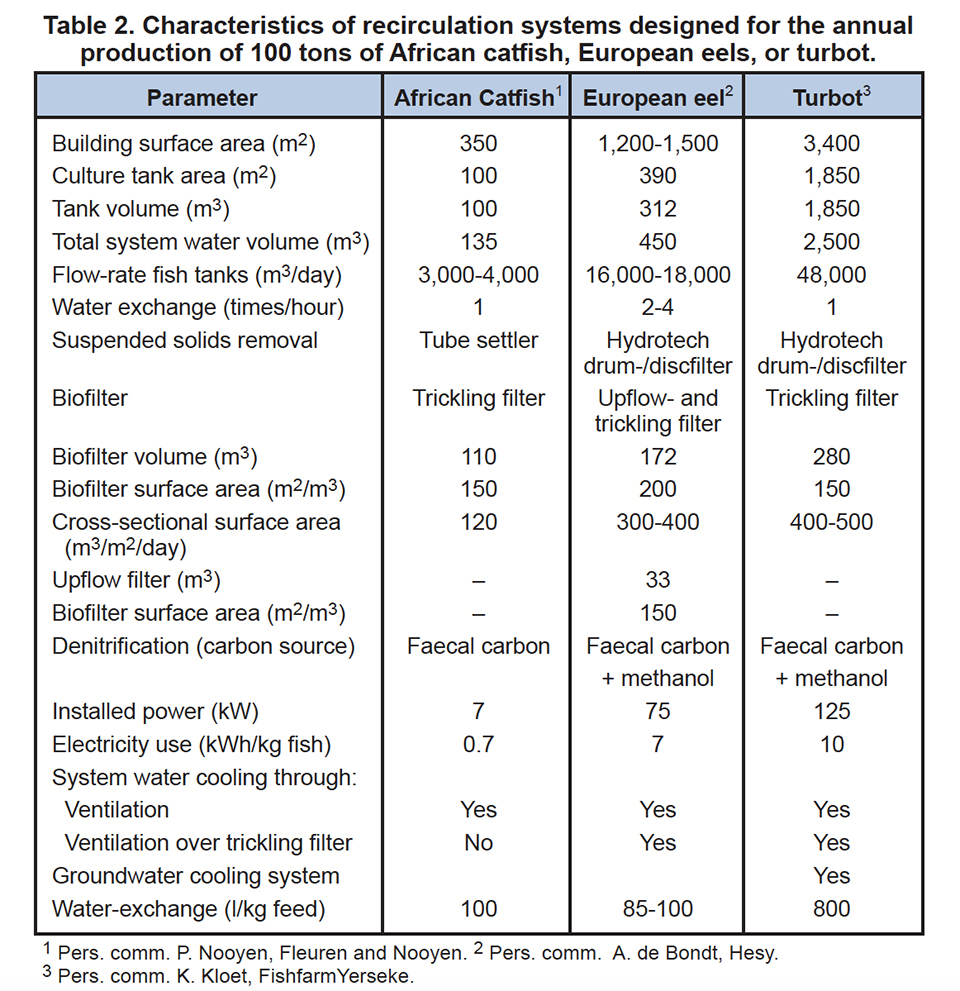Systems can be adjusted for African catfish, European eel, turbot, others

Because of its number and diversity of recirculation systems in production, the Netherlands offers an interesting opportunity to study differences in system design that pertain to the species farmed. In addition to established industries for eel and catfish production (with respective annual production of about 4,800 and 4,000 metric tons (MT)), new species like tilapia, turbot, sole, and pike perch are gaining ground in the country.
All production systems use the same basic technology with some specific adaptations for each species. The differences in systems for eels, catfish, and turbot are good examples of these adaptions. To understand the differences in design, however, it is important to compare the biological performance of the farmed animals (Table 1).

Productivity
Productivity depends on density and growth rates, among other variables, and these differ significantly between the three species. Catfish production is extremely high at 1,000 to 1,500 kilograms per square meter per year, while eels can produce 200 to 300 kilograms per square meter per year and turbot reach 55 kilograms per square meter per year.
Growth, FCR and waste
Growth rate and body composition affect feed conversion, which is important in determining the amount of waste produced. Waste production ultimately determines the capacity of water treatment systems. Fast growth is efficient growth, represented by the African catfish. Eels are a very fatty fish with a moderate growth rate that results in relatively high feed conversions.
Dissolved oxygen
Oxygen is one of the factors that first limit production, and its consumption is a determinant of the recirculating flow. Since African catfish can utilize atmospheric oxygen and live in water devoid of oxygen, the fish require only a small recirculating flow. This lower flow rate allows the use of lamella sedimentation (tube settlers) rather than more expensive microscreen filters (Fig. 1).
System characteristics
Table 2 shows the characteristics of recirculation systems designed in the Netherlands for the annual production of 100 tons of African catfish, European eel, or turbot. Given the different productivities of each, the area needed for tanks and a building are very different for each species. This has important consequences, for capital costs for land and buildings are considerable for those species with low productivity.


Managing waste
Only microscreens are used to manage the large flows of water and waste in eel and turbot farms (Fig. 2). For nitrification and removal of soluble biological oxygen demand, all systems predominantly use trickling filters.
In general, the total recirculating flow is pumped over the biofilter in order to guarantee optimal removal of carbon dioxide. This results in a large difference in hydraulic surface loads between systems. The trickling filters can handle these differences, and also avoid clogging with high loading.
Biofilters
Catfish produce relatively little waste and have high tolerance for less than ideal water quality, so a relatively small biofilter is used. For turbot, which are cultured in seawater, the negative effect of chloride on nitrification has to be taken into account when sizing the biofilter. A submerged upflow filter is used in some eel farms to remove small particles. The need and design of this piece of equipment is still being debated.
Denitrification and water use
Fresh water is an expensive resource, and denitrification is becoming routine in farms for catfish and eels. Catfish farms use settling areas, with sludge management and settler sizing considered important management processes. Most eel farms now operate with denitrification using feces or methanol as a carbon source. Because of denitrification, water exchange ranges between 100 liters per kilogram feed for catfish and eels, to 800 liters per kilogram feed for turbot.
Energy-friendly systems
Once a recirculation system is planned for a fish species, the building or greenhouse has to be designed. Computer models like ANIPRO are now being used to design energy-friendly recirculation systems. Models can simulate climate and energy use in recirculation system buildings and design energy-efficient, cost-effective heating and cooling systems for fish farms in different geographical regions. Climate control through ventilation and/or groundwater cooling is has received attention, especially for species like turbot, which require moderate water temperatures.
Heat management
The ANIPRO model incorporates heat production in the fish farm through the conversion of feed from fish and bacterial biomass, pumps, lighting (including ultraviolet lighting for disinfection), and heat transmission into the building (especially solar radiation). Heat loss occurs by air ventilation; transmission of heat through the floors, walls, and roof; and water renewal.
Specific data has been collected for catfish, eels, and now turbot farms. Parameters in the model were obtained from literature and fine-tuned with on-farm measurements for African catfish and European eels. The model has been recently extended with a simulation for greenhouses.
Conclusion
Several fish species – including European eel, African catfish and turbot – are currently produced in the Netherlands using recirculation systems. Other fish species are also becoming important.
The production systems use the same basic technology with specific adaptations for each species. Efficient management of waste and physical systems designed to be energy-friendly are important considerations for further industry development.
(Editor’s Note: This article was originally published in the June 2002 print edition of the Global Aquaculture Advocate.)
Now that you've finished reading the article ...
… we hope you’ll consider supporting our mission to document the evolution of the global aquaculture industry and share our vast network of contributors’ expansive knowledge every week.
By becoming a Global Seafood Alliance member, you’re ensuring that all of the pre-competitive work we do through member benefits, resources and events can continue. Individual membership costs just $50 a year. GSA individual and corporate members receive complimentary access to a series of GOAL virtual events beginning in April. Join now.
Not a GSA member? Join us.
Authors
-
Ep Eding
Group Fish Culture and Fisheries
Wageningen-UR, The Netherlands -
Andries Kamstra
RIVO, Netherlands Institute for Fisheries Research
Wageningen-UR, The Netherlands
Tagged With
Related Posts

Responsibility
Airlifts combine pumping, water treatment in recirculation systems
Using the buoyancy of the entrained air bubbles to lift the water, airlifts are more energy-efficient and provide more aeration, carbon dioxide removal and foam fractionation for dissolved solids removal than centrifugal pump systems.

Responsibility
Automated temperature-controlled recirculation systems
A temperature-control system with a central chiller was found to enhance chilling and research capacity over a system with multiple unit chillers because replicating experiments in a single process control system minimized variations in the temperatures and chilling rates in the individual tanks. Temperature-holding experiments found slight differences at different temperature levels.

Intelligence
10 takeaways from GOAL 2019 in Chennai, India
The Global Aquaculture Alliance held its GOAL conference in Chennai, India, and recruited a host of experts in various fields to share their expertise.

Intelligence
Dutch shellfish farmers bringing the sea onto land
Bivalve shellfish culture is a low-impact form of protein production, and in many cases is a net-positive for water quality. So why move it indoors? Smit & Smit in the Netherlands has a good argument for doing so.


